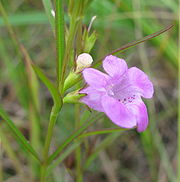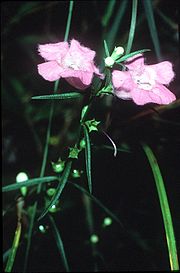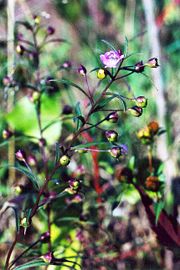
Agalinis
Encyclopedia
Agalinis Raf. is a genus of about 70 species in North, Central, and South America that until recently was aligned with members of the family Scrophulariaceae
. As a result of numerous molecular phylogenetic studies based on various chloroplast
DNA
(cpDNA) loci, it was shown to be more closely related to members of the Orobanchaceae
. Agalinis spp. are hemiparasitic, which is a character that in part describes the Orobanchaceae
.
The first detailed study of this genus began with Francis W. Pennell around 1908, and his earliest major publication of the North American members of this genus appeared in 1913. Dr. Judith Canne-Hilliker began to revise Pennell's treatment in 1977. Her taxonomic, anatomical, and developmental studies have greatly enhanced our understanding of this sometimes perplexing group. In particular, her studies of the seed surfaces using electron microscopy has shown that the seeds are diagnostic for delimiting species and has resulted in a relignment of Pennell's classification of the group. In the 1990s Greg Dieringer investigated the reproductive ecology of several Agalinis spp., to include the self-incompatible Agalinis strictifolia and the autogamous bee-visited Agalinis skinneriana. Much remains to be studied in this regard, however.
One species of Agalinis, Agalinis acuta
, is federally-listed. This is mainly due to continued habitat loss within its historically-known range. There are a number of species in North America that are ranked at the state and federal level. However, many of the species considered rare are ranked at the state level and represent species on the periphery of their range. There are a number of rare (and endemic) species that are not noted at the state or federal level, and the biogeography of this group in North America has yet to be studied in detail, and is poorly understood.
Below is a list of currently-recognized species of Agalinis that occur in North America.
Scrophulariaceae
Scrophulariaceae, the figwort family, are a family of flowering plants. The plants are annual or perennial herbs with flowers with bilateral or rarely radial symmetry. Members of the Scrophulariaceae have a cosmopolitan distribution, with the majority found in temperate areas, including...
. As a result of numerous molecular phylogenetic studies based on various chloroplast
Chloroplast
Chloroplasts are organelles found in plant cells and other eukaryotic organisms that conduct photosynthesis. Chloroplasts capture light energy to conserve free energy in the form of ATP and reduce NADP to NADPH through a complex set of processes called photosynthesis.Chloroplasts are green...
DNA
DNA
Deoxyribonucleic acid is a nucleic acid that contains the genetic instructions used in the development and functioning of all known living organisms . The DNA segments that carry this genetic information are called genes, but other DNA sequences have structural purposes, or are involved in...
(cpDNA) loci, it was shown to be more closely related to members of the Orobanchaceae
Orobanchaceae
Orobanchaceae, the broomrape family, is a family of flowering plants of the order Lamiales, with about 90 genera and more than 2000 species. Many of these genera were formerly included in the family Scrophulariaceae sensu lato...
. Agalinis spp. are hemiparasitic, which is a character that in part describes the Orobanchaceae
Orobanchaceae
Orobanchaceae, the broomrape family, is a family of flowering plants of the order Lamiales, with about 90 genera and more than 2000 species. Many of these genera were formerly included in the family Scrophulariaceae sensu lato...
.
The first detailed study of this genus began with Francis W. Pennell around 1908, and his earliest major publication of the North American members of this genus appeared in 1913. Dr. Judith Canne-Hilliker began to revise Pennell's treatment in 1977. Her taxonomic, anatomical, and developmental studies have greatly enhanced our understanding of this sometimes perplexing group. In particular, her studies of the seed surfaces using electron microscopy has shown that the seeds are diagnostic for delimiting species and has resulted in a relignment of Pennell's classification of the group. In the 1990s Greg Dieringer investigated the reproductive ecology of several Agalinis spp., to include the self-incompatible Agalinis strictifolia and the autogamous bee-visited Agalinis skinneriana. Much remains to be studied in this regard, however.
One species of Agalinis, Agalinis acuta
Agalinis acuta
Agalinis acuta is an annual hemiparasitic plant plant native to Maryland, Massachusetts, Rhode Island, Connecticut, and Long Island, New York. Common names include sandplain gerardia and sandplain false foxglove. It is one of about 70 species that comprise genus Agalinis...
, is federally-listed. This is mainly due to continued habitat loss within its historically-known range. There are a number of species in North America that are ranked at the state and federal level. However, many of the species considered rare are ranked at the state level and represent species on the periphery of their range. There are a number of rare (and endemic) species that are not noted at the state or federal level, and the biogeography of this group in North America has yet to be studied in detail, and is poorly understood.
Below is a list of currently-recognized species of Agalinis that occur in North America.
| Agalinis acuta Agalinis acuta Agalinis acuta is an annual hemiparasitic plant plant native to Maryland, Massachusetts, Rhode Island, Connecticut, and Long Island, New York. Common names include sandplain gerardia and sandplain false foxglove. It is one of about 70 species that comprise genus Agalinis... |
sandplain false foxglove | |
| Agalinis aphylla | scaleleaf false foxglove | |
| Agalinis aspera Agalinis aspera Agalinis aspera is a non-poisonous plant of the genus Agalinis, habitating in the dry prairies. It can grow to be about eight to twenty-four inches tall. When the flowers bloom, the colors vary between purple and pink.The tall foxglove is native to some parts of the United States and Canada... |
harsh stem false foxglove | |
| Agalinis auriculata | earleaf false foxglove | |
| Agalinis caddoensis | Caddo false foxglove | |
| Agalinis calycina | Leoncita false foxglove | |
| Agalinis densiflora | Osage false foxglove | |
| Agalinis divaricata | pineland false foxglove | |
| Agalinis edwardiana | Edward's Plateau false foxglove | |
 |
Agalinis fasciculata | tall false foxglove |
| Agalinis filicaulis | delicate false foxglove | |
| Agalinis filifolia | Florida false foxglove | |
| Agalinis gattingeri | Midwest false foxglove | |
| Agalinis georgiana | Georgia false foxglove | |
| Agalinis harperi | Gulf Coastal Plain false foxglove | |
| Agalinis heterophylla | old field false foxglove | |
| Agalinis homolantha | San Antonio false foxglove | |
| Agalinis laxa | long-pediceled false foxglove | |
| Agalinis linifolia | perennial false foxglove | |
| Agalinis maritima | saltmarsh false foxglove | |
| Agalinis navasotensis | Navasota false foxglove | |
| Agalinis neoscotica | Nova Scotia false foxglove | |
| Agalinis obtusifolia | variable false foxglove | |
| Agalinis oligophylla | ridgestem false foxglove | |
 |
Agalinis paupercula | boreal false foxglove |
| Agalinis plukenetii | slenderleaf false foxglove | |
| Agalinis pulchella | savanna false foxglove | |
 |
Agalinis purpurea | purple false foxglove |
| Agalinis setacea | threadleaf false foxglove | |
| Agalinis skinneriana | Skinner's false foxglove | |
| Agalinis strictifolia | clasping false foxglove | |
 |
Agalinis tenuifolia | bushy false foxglove |
| Agalinis viridis | green false foxglove |

